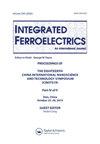丝素/氨基酸杂化有机压电-摩擦电纳米发电机
IF 0.7
4区 工程技术
Q4 ENGINEERING, ELECTRICAL & ELECTRONIC
引用次数: 0
摘要
摘要摩擦电纳米发电机(TENG)具有良好的性能和可生物降解性,是新型医疗设备和可穿戴电子产品的扩展所需要的。本研究旨在通过包埋有机压电γ-甘氨酸(γ-gly)氨基酸,制备丝素(SF)薄膜形式的天然丝用于TENG,并进一步提高其输出效率,作为混合有机压电/摩擦电纳米发电机(HO-P/TENG)。衰减全反射红外光谱(ATR-IR)结果表明,SF和SF/γ-gly具有N-H、C = O和C- n键,证实了其主导作用,具有较强的供电子倾向。扫描电镜(SEM)和同步辐射x射线层析显微镜(SR-XTM)图像显示,掺入的γ-gly在SF基体表面和内部具有良好的分散性,这与其含量有关,从而均匀地提高了电性能。在垂直接触分离模式下,SF/γ-gly HO-P/TENG在15 wt%时的最大输出电压(VOC)为81 V,最大输出电流(ISC)为121 μA,最大输出功率(Pmax)为205 μW,外部负载电阻为5 MΩ。这种基于sf的HO-P/TENG具有成本效益高,制造简单的优点,具有很大的实际应用前景。关键词:丝素蛋白氨基酸杂化有机压电摩擦纳米发电机披露声明作者未报告潜在利益冲突。Thitirat Charoonsuk的工作是由高等教育、科学、研究和创新部(OPS MHESI)、泰国科学研究和创新(TSRI)和斯里那卡林沃特大学的常任秘书办公室资助的,资助号为RGNS 64-211。Naratip Vittayakorn的工作得到了KMITL的资助。KREF116501。Jitrawan Noisak的工作得到了蒙库特国王理工学院(KMITL)的资助。T. Bongkarm的工作得到了那理大学(NU)和国家科学研究与创新基金(NSRF)的支持,批准号为:R2567B001。本文章由计算机程序翻译,如有差异,请以英文原文为准。
Silk Fibroin/Amino Acid Hybrid Organic Piezoelectric-Triboelectric Nanogenerator
AbstractTriboelectric nanogenerators (TENG) with great performance and biodegradability are desired for the expansion of novel medical devices and wearable electronics. The present study aims at the preparation of natural silk in the form of silk fibroin (SF) film for utilization in TENG and further improving its output efficiency by embedding organic-piezoelectric gamma-glycine (γ-gly) amino acid to be a hybrid-organic piezoelectric/triboelectric nanogenerator (HO-P/TENG). The attenuated total reflectance infrared spectroscopy (ATR-IR) results demonstrated the N-H, C = O, and C-N bonding for SF and SF/γ-gly, confirming its dominant effect with a strong electron-donating tendency from those amino groups. The scanning electron microscope (SEM) and synchrotron radiation X-ray tomographic microscopy (SR-XTM) images show good dispersibility of incorporated γ-gly on the surface and also inside the SF matrix relating to its content to improve the electrical performance homogeneously. By fabricating the device in the vertical contact-separation mode, the present SF/γ-gly HO-P/TENG at 15 wt% provides the maximum output voltage (VOC) and current (ISC) of 81 V and 121 μA with a maximum output power (Pmax) of 205 μW at the external load resistance of 5 MΩ. This SF-based HO-P/TENG has the advantage of being cost-effective with simple fabrication, demonstrating great promise for practical uses.Keywords: Silk fibroinamino acidhybrid organic piezoelectric-triboelectric nanogenerator Disclosure StatementNo potential conflict of interest was reported by the author(s).Additional informationFundingThe work of Thitirat Charoonsuk was funded by the Office of the Permanent Secretary, Ministry of Higher Education, Science, Research, and Innovation (OPS MHESI), Thailand Science Research and Innovation (TSRI), and Srinakharinwirot University under the Grant number RGNS 64-211. The work of Naratip Vittayakorn was supported by KMITL under Grant No. KREF116501. The work of Jitrawan Noisak was supported by King Mongkut’s Institute of Technology Ladkrabang (KMITL) under Grant No. KREF016412 and The work of T. Bongkarm was supported by Naresuan University (NU) and National Science, Research and Innovation Fund (NSRF) with Grant No. R2567B001.
求助全文
通过发布文献求助,成功后即可免费获取论文全文。
去求助
来源期刊

Integrated Ferroelectrics
工程技术-工程:电子与电气
CiteScore
1.40
自引率
0.00%
发文量
179
审稿时长
3 months
期刊介绍:
Integrated Ferroelectrics provides an international, interdisciplinary forum for electronic engineers and physicists as well as process and systems engineers, ceramicists, and chemists who are involved in research, design, development, manufacturing and utilization of integrated ferroelectric devices. Such devices unite ferroelectric films and semiconductor integrated circuit chips. The result is a new family of electronic devices, which combine the unique nonvolatile memory, pyroelectric, piezoelectric, photorefractive, radiation-hard, acoustic and/or dielectric properties of ferroelectric materials with the dynamic memory, logic and/or amplification properties and miniaturization and low-cost advantages of semiconductor i.c. technology.
 求助内容:
求助内容: 应助结果提醒方式:
应助结果提醒方式:


